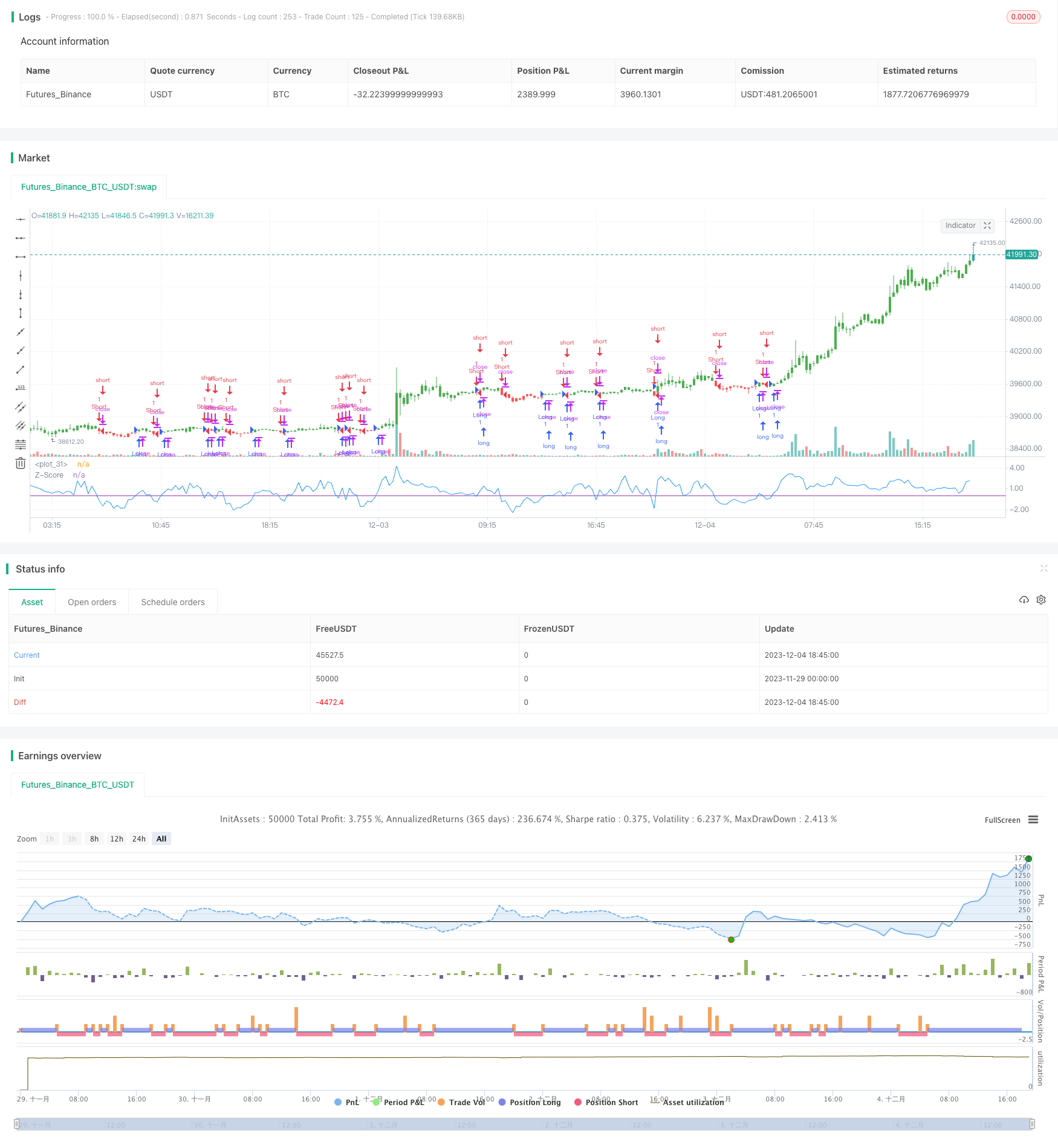Z-Score Price Breakout Strategy
Author: ChaoZhang, Date: 2023-12-07 15:17:43Tags:

Overview
The Z-Score price breakout strategy uses the z-score indicator of price to determine whether the current price is in an abnormal state, so as to generate trading signals. When the z-score of price is higher or lower than a threshold, it means the price has entered an abnormal state, at which point long or short positions can be taken.
Strategy Principle
The core indicator of this strategy is the z-score of price, calculated as follows:
Z_score = (C - SMA(n)) / StdDev(C,n)
Where C is the closing price, SMA(n) is the simple moving average of n periods, and StdDev(C,n) is the standard deviation of closing price for n periods.
The z-score reflects the degree of deviation of the current price from the average price. When the price z-score is greater than a certain positive threshold (e.g. +2), it means the current price is above the average price by 2 standard deviations, which is a relatively high level. When it is less than a certain negative threshold (e.g. -2), it means the current price is below the average price by 2 standard deviations, which is a relatively low level.
This strategy first calculates the z-score of price, then sets a positive and negative threshold (e.g. 0 and 0). When the z-score is higher than the positive threshold, it generates a buy signal. When lower than the negative threshold, it generates a sell signal.
Advantage Analysis
- Using price z-score to judge price anomalies is a common and effective quantitative method
- Easily achieve both long and short trading
- Flexible parameter settings, adjustable cycle, threshold, etc.
- Can be combined with other indicators to form a trading system
Risk Analysis
- The z-score strategy is crude and prone to false signals
- Need to set appropriate parameters like cycle and threshold
- Need to consider stop loss strategies to control risk
Optimization Directions
- Optimize cycle parameters to find the best cycle
- Optimize positive and negative thresholds to reduce false signals
- Add filter conditions, combine with other indicators
- Add stop loss strategies
Summary
The z-score price breakout strategy judges whether the current price is in an abnormal state, and trades according to the positive and negative of the price z-score. This strategy is simple and easy to implement, allows two-way trading, but also has some risks. By optimizing parameters, adding stop loss and combining with other indicators, this strategy can be enhanced to form a complete quantitative trading system.
/*backtest
start: 2023-11-29 00:00:00
end: 2023-12-04 19:00:00
period: 15m
basePeriod: 5m
exchanges: [{"eid":"Futures_Binance","currency":"BTC_USDT"}]
*/
//@version=2
////////////////////////////////////////////////////////////
// Copyright by HPotter v1.0 18/01/2017
// The author of this indicator is Veronique Valcu. The z-score (z) for a data
// item x measures the distance (in standard deviations StdDev) and direction
// of the item from its mean (U):
// z = (x-StdDev) / U
// A value of zero indicates that the data item x is equal to the mean U, while
// positive or negative values show that the data item is above (x>U) or below
// (x Values of +2 and -2 show that the data item is two standard deviations
// above or below the chosen mean, respectively, and over 95.5% of all data
// items are contained within these two horizontal references (see Figure 1).
// We substitute x with the closing price C, the mean U with simple moving
// average (SMA) of n periods (n), and StdDev with the standard deviation of
// closing prices for n periods, the above formula becomes:
// Z_score = (C - SMA(n)) / StdDev(C,n)
// The z-score indicator is not new, but its use can be seen as a supplement to
// Bollinger bands. It offers a simple way to assess the position of the price
// vis-a-vis its resistance and support levels expressed by the Bollinger Bands.
// In addition, crossings of z-score averages may signal the start or the end of
// a tradable trend. Traders may take a step further and look for stronger signals
// by identifying common crossing points of z-score, its average, and average of average.
//
// You can change long to short in the Input Settings
// Please, use it only for learning or paper trading. Do not for real trading.
////////////////////////////////////////////////////////////
strategy(title="Z-Score Strategy", shorttitle="Z-Score Strategy")
Period = input(20, minval=1)
Trigger = input(0)
reverse = input(false, title="Trade reverse")
hline(Trigger, color=purple, linestyle=line)
xStdDev = stdev(close, Period)
xMA = sma(close, Period)
nRes = (close - xMA) / xStdDev
pos = iff(nRes > Trigger, 1,
iff(nRes < Trigger, -1, nz(pos[1], 0)))
possig = iff(reverse and pos == 1, -1,
iff(reverse and pos == -1, 1, pos))
if (possig == 1)
strategy.entry("Long", strategy.long)
if (possig == -1)
strategy.entry("Short", strategy.short)
barcolor(possig == -1 ? red: possig == 1 ? green : blue )
plot(nRes, color=blue, title="Z-Score")
- Bollinger Bands Reversal Trend Strategy
- StochRSI Based Quantitative Trading Strategy
- Dual EMA Engulfing Breakout Strategy
- Alligator RSI Trading Strategy
- RSI and Stochastic RSI Combination Strategy
- Double Rail Breakthrough Moving Average Crossover Strategy
- Short-term Trading Strategy Based on SMA and EMA
- Dynamic Momentum Strategy
- John's Bitcoin Intraday Trading Strategy Based on Multiple Indicators
- Slow Moving Average Strategy
- Fibonacci Retracement Reversal Strategy
- Dual-factor Quant Trading Strategy
- Dual EMA Golden Cross Trading Strategy
- BTC Trading Strategy Based on Moving Average Crossover
- MACD Indicator Bottom Reversal Early Warning Strategy
- Mala's Adaptive Moving Average Strategy
- Golden Ratio Mean Reversion Trend Trading Strategy
- Trend Trading Strategy Based on Multiple Moving Averages
- Dual Indicator Filtered Buy Signal Strategy
- Dual Moving Average Crossover Trading Strategy